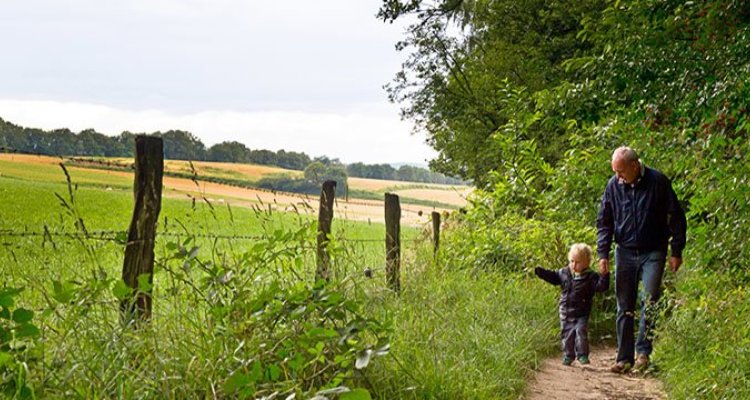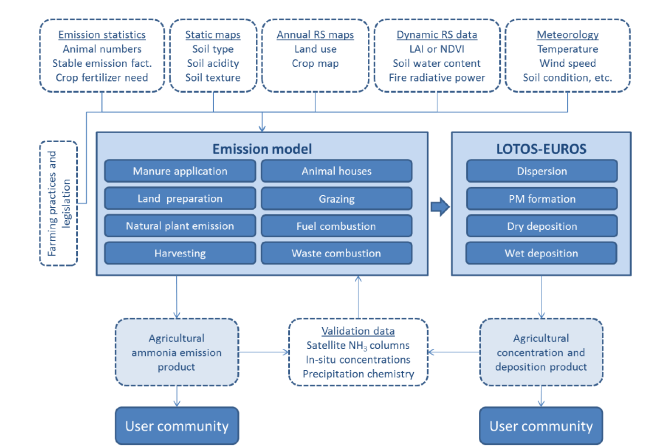
Project
Ammonia emissions from agriculture optimized by earth observations (AMARETTO)
Emissions of ammonia to air from the agricultural sector have large negative societal impacts. Ammonia contributes to eutrophication and acidification of terrestrial and marine ecosystems and loss of biodiversity. Despite its central role in many environmental threats, the uncertainty in agricultural ammonia emissions is large.
This project aims to improve the quantification of agricultural ammonia emissions at European scale using earth observation and meteorological data which will increase insight in the temporal dynamics of agricultural practices and emissions over the year. The contribution of the agricultural sector to nitrogen deposition in Europe will thus be quantified, being a crucial product in view of biodiversity impacts.
Objectives
The overall objective of AMARETTO is to quantify the impact of agriculture on loads of ammonia at European scale based on the optimization of a dynamic agricultural emission model within LOTOS-EUROS through earth observation products. Specific objectives of AMARETTO are to:
- Improve the understanding of processes and mechanisms that induce the variability in ammonia emissions, concentrations and deposition;
- Develop methodologies and parameterizations to detail agricultural emissions in space and time with information on practices, vegetation growth, surface conditions and atmospheric concentrations from various sources including remote sensing;
- Provide a standardized processing chain to provide ammonia emissions and concentration distributions based on detailed land use and assimiliation of satellite data.

Methods
The quantification of agricultural ammonia emissions at European scale will be improved using earth observation and meteorological data which will increase insight in the temporal dynamics of agricultural practices and emissions over the year. The atmospheric ammonia budget will be modelled using LOTOS-EUROS. The novel emission product will be verified using ammonia column data from IASI and CrIS, and surface concentration from in-situ observations. Finally, ammonia emission strengths will be inverted from the IASI data with LOTOS-EUROS. More in detail, the activities are:
Improvement of spatial and temporal allocation based on available models
- Inclusion of spatial allocation with INTEGRATOR
- Inclusion of time dependent housing and application emissions: agricultural activity timer
Improvement of spatial and temporal allocation in available emission models
- Improvement of the spatial and temporal allocation of farming practices
- Improvement of the spatial detail of agricultural activity data
- Evaluation of emission variability over Benelux, Denmark and Portugal
- Predict ammonia emissions in response to improved agricultural practices and changing climate
Results and publications
The most important results and insights from this project until now are:
1. After the use of an agricultural management module TIMELINES, which provided predictions of the timing of key agricultural operations including the day of fertilization, and the emission model INTEGRATOR, that gave more details on spatial distribution, modelled ammonia concentrations compared better with in situ measurements and with satellite observations in Germany and the Benelux. The improved ammonia concentration results simulated by the chemistry transport model LOTOS-EUROS illustrated that both the temporal and spatial variation of ammonia emission had been improved. More information is given in Ge et al (2020).
2. By using high spatial resolution crop map (derived from Sentinel-2 with machine learning) and livestock housing information in LOTOS-EUROS, the modelled monthly and annual averaged ammonia surface concentrations compared better with observations than those derived with the standard model in the Netherlands, which indicated that both the temporal and spatial allocation of ammonia emission have been improved. More information is given in Ge et al (2023).
Publications
- Ge, X., M. Schaap, R. Kranenburg, A. Segers, G.J. Reinds, J. Kros and W. de Vries, 2020. Modeling Atmospheric Ammonia using Agricultural Emissions with Improved Spatial Variability and Temporal Dynamics. Atmos. Chem. Phys. 20, 16055–16087. https://acp.copernicus.org/articles/20/16055/2020/
- Ge, X., M. Schaap and W. de Vries, 2023. Improving spatial and temporal variation of ammonia emissions for the Netherlands using livestock housing information and a Sentinel-2-derived crop map. Atmospheric Environment: X Volume 17, 2023, 100207 https://doi.org/10.1016/j.aeaoa.2023.100207
- Ge, X., M. Schaap, E. Dammers, M. Shephard and W. de Vries, 2023. Impact of interannual weather variation on ammonia emissions in Germany: a multi-year analysis. Agricultural and forest meteorology https://doi.org/10.1016/j.agrformet.2023.109432